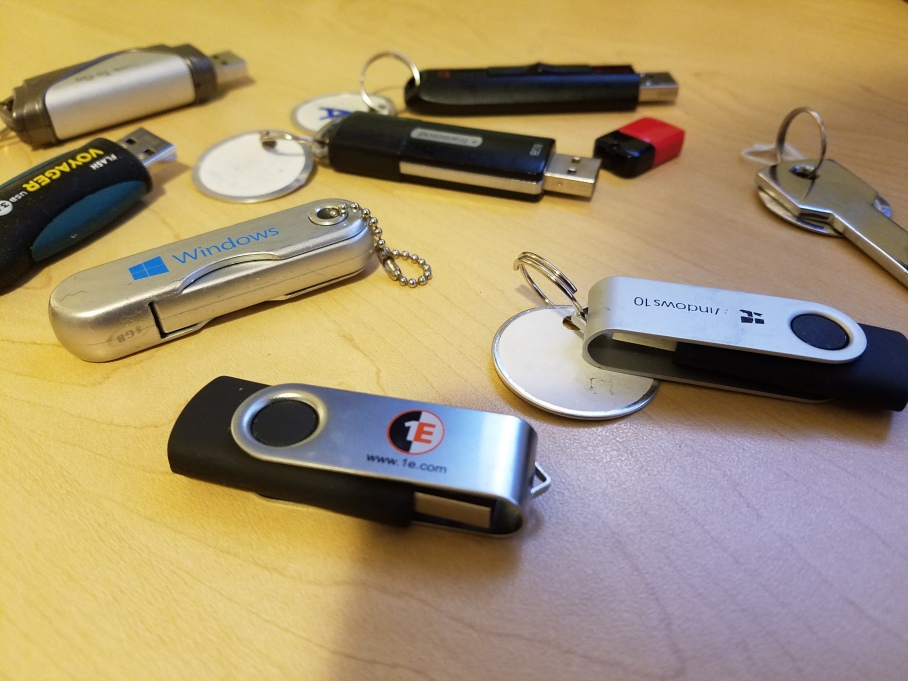TL;DR – Starting with Windows 10 Insider Preview Build 14965, you can format any “Removable” USB Flash Drive with more than one partition. Perfect for installation of large (over 4GB) WIM files on UEFI machines!
Hey all, back from a week at the Microsoft MVP summit, a Week in the UK, and a week in Arizona.
A few weeks ago at the Microsoft MVP summit, an engineering manager with the Windows Product group made an offhand comment about formatting a removable USB drive with two partitions. This took several of us by surprise, because historically, this hasn’t been supported widely without converting to a Fixed disk or something.
Mike Terrill (and Mike Niehaus) already beat me to the punch with some posts, but I wanted to share my results. :^)
The Background
Why is this important? Well as I mentioned in another blog post, as more and more people are booting to UEFI, on USB flash drives formatted with Fat32, with WIM images over 4GB in size, that causes a problem because Fat32 can’t hold files over 4GB in size.
Another solution would be to use the Rufus tool to split a USB drive into multiple partitions with a hidden fat32 partition. However, the problem here is that the hidden partition uses a special UEFI app that is not signed, so it won’t work on UEFI machines with Secure Boot enabled.
This has become even more interesting since Windows Server 2016 came out, with a base WIM image for standard Server SKU that is over 4GB in size. Hum…
The Hardware

I tested on several different USB makes using my Windows 10 (version 1607) laptop. Some would allow me to create a 2nd partition on a removable Flash Drive, others would not giving me an error:
DISKPART> create part pri No usable free extent could be found. It may be that there is insufficient free space to create a partition at the specified size and offset. Specify different size and offset values or don't specify either to create the maximum sized partition. It may be that the disk is partitioned using the MBR disk partitioning format and the disk contains either 4 primary partitions, (no more partitions may be created), or 3 primary partitions and one extended partition, (only logical drives may be created).
Mostly the older and/or cheaper drives didn’t work, but most of the newer and/or name brand drives did work.
Finally I narrowed it down to two different models, both my favorites:
- Sandisk Extreme USB 3.0 Flash Drive – 32GB – 2 years old – worked flawlessly.
- Transcend 8GB JetFlash V10 USB 2.0 Flash Drive – 6+ years old – would not create a 2nd partition no matter what I tried on Windows 10 Version 1607
Then I tested against three Operating Systems: Windows 10 Version 1607, Windows 10 Preview, and Windwos 7.0 SP1. All using Diskpart to create multiple partitions.
The script
Diskpart.exe –>
sel disk 1 clean create part pri size=450 format quick fs=fat32 assign create part pri format quick fs=ntfs assign exit
The Results:
SanDisk Transcend Windows 7 SP1 Build 7601 Pass Fail Windows 10 Version 1607 Pass Fail Windows 10 Preview 14965 Pass Pass
I was able to format my SanDisk into multiple partitions using Windows 7 and beyond.
But I was not able to format the Transcend drive into multiple partitions using Windows 7 or Windows 10 Version 1607, but I was able to partition into multiple partitions on the new Windows 10 Insider Preview 14965.
That’s new!
I haven’t done enough testing using the removable flash drives on older machines, to see if the partitions are still visible, but the results look promising for a start.
Update #1 – 11/28/16:
Found out today that the reason that my SanDisk Extreme disk worked on Windows 7 and Windows 10 1607 may be because the removable Flash disk is reported as “Fixed” rather than “Removable” to the OS. Link.
Update #2 – 11/28/16:
I noticed that when taking the “removable” disk formatted with 2 partitions from Windows 10 Preview 14965 over to Windows 10 Version 1607, only the first partition was visible. As a work around I tried moving the main NTFS partition first and the Fat32 partition second.
sel disk 1 clean create part pri shrink desired=450 format quick fs=ntfs assign create part pri format quick fs=fat32 assign exit
